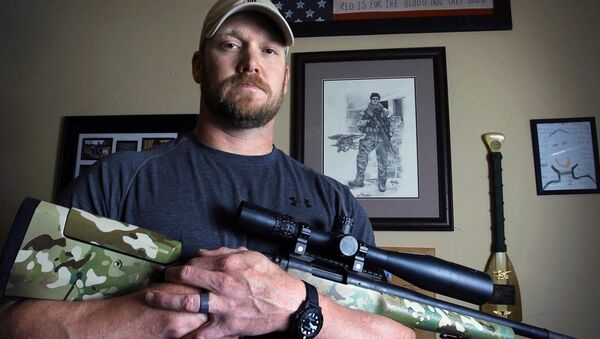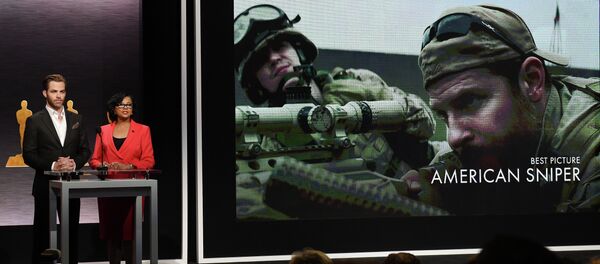A Texas jury found former Marine Eddie Ray Routh guilty of capital murder; in 2013 he shot to death former Navy SEAL Chris Kyle, the man behind American Sniper – the book later turned into a blockbuster movie directed by Hollywood icon Clint Eastwood. Texas Governor Greg Abbott also made his mark, post-verdict, by tweeting "JUSTICE!"
It didn’t matter that Routh’s attorneys — and his family – insisted he suffered from psychosis, caused by post-traumatic stress disorder (PTSD). Texas prosecutors easily brushed it off – "proving" Routh’s episodes of PTSD were provoked by alcohol and marijuana.
Poetic justice does intervene, and the Ultimate Sniper also becomes dehumanized himself. He is diagnosed with PTSD.
In a cruel twist of fate, he ends up eviscerated back home, on a firing range, by someone he was trying to help; a serviceman with – you guessed it – PTSD.
For every US soldier killed in 2014, no less than 25 veterans committed suicide. For the second year in a row, the Pentagon has lost more troops to suicide than to combat. Ah, but in Texas, this stuff is for sissies.
Kyle, according to his own version, made more than 300 kills as a sniper for SEAL Team 3. After he left the military, his atonement was to help with war veterans facing PTSD, usually taking them to – what else — shooting.
Clint Eastwood is way more nuanced than he is given credit for — as his deceptively shallow interviews over the years may imply. It just might be that, appealing for the basest instincts, he may have enshrined yet another American hero to better deliver an anti-war movie.
Which brings us to the American Sniper’s ultimate opposite number: Juba.
Aiming for that lone shot
Juba became a legend across the Arab world because he only targeted "coalition" soldiers – as in the invading/occupying troops, all heavily protected by armored vehicles, body armor and helmets. Translation; he only killed Americans who were led to believe – by the Pentagon and the corporate media machine — they were "liberating" Iraq from Saddam, who was allied with al-Qaeda and "attacked us on 9/11". I heard this straight from many a soldiery mouth – no irony intended.
Juba scored kills from up to 200 meters away – something that American Sniper would be hard pressed to accomplish.
Juba was infinitely patient, and devastatingly accurate. He would fire only one shot – and then change his position. He never fired a second shot. He aimed for the tiniest gap in the soldiers' body armor, and target their lower spine, ribs or above the chest. No US specialist sniper team was ever able to track him.
That explains, in a nutshell, why Juba became an urban legend in Baghdad, the Sunni triangle, and beyond. What is virtually certain is that he was a member of the Islamic Army in Iraq (jaysh al islāmi fī'l-'irāq). A hero of the resistance against the invaders, of course, but far from a Salafi-jihadi.
The Islamic Army in Iraq, by the mid-2000s, was the number one resistance group against the Americans, as promoted by former Iraqi vice-president Tariq al-Hashemi. They were all former Ba'athists – Sunnis, Shi'ites and Kurds working together. And so was Juba – who was thought to be Sunni. But that was never totally confirmed.
By the end of 2005 the Islamic Army in Iraq released a 15-minute video of Juba’s Greatest Kills. By mid-2006 all sorts of figures were circulating about his real tally. That included feats such as Juba eviscerating a four-strong marine scout sniper team in Ramadi, in the "triangle of death", all of them with a single shot to the head.
US snipers were always deployed in teams of at least two, a shooter and a spotter. A spotter had to be extremely experienced, using very complex calculus to factor, for instance, wind variations and drag coefficients. Juba, instead, was a loner.
Rebel with a Dragunov
The Islamic Army of Iraq liked to boast that Juba – and other snipers – were trained essentially by the book 'The Ultimate Sniper: An Advanced Training Manual for Military and Police Snipers' (Paladin Press, 1993; expanded edition in 2006), written by retired US sniper John Plaster.
What a fabulous post-Cold War tale; tactics may have been borrowed from the (American) invader; but the weapon of choice was Russian.
Juba's usual "nest" – where he holed up before a kill — was invariably decorated by an assortment of bed mattresses, which muffled the sound of his Dragunov sniper rifle, also known as SVD; a semi-automatic designed by Evgeniy Dragunov in the former USSR in the late 1950s. The SVD has always been highly regarded as the world's first purpose-built military precision marksman’s rifle. So considering the close relations between the USSR and Saddam’s Iraq, no wonder the Ba'athist military was familiar with the Dragunov.
Juba's trademark "souvenir" also became as legendary as his Invisible Man persona; a lone bullet casing, and a few words jotted down in Arabic: What has been taken in blood cannot be regained except by blood. The Baghdad Sniper.
There was a time in late 2005, early 2006, when I was following the Iraqi resistance closely even when I was not on the ground, that I flirted with the idea of writing a screenplay about Juba. He was a sort of Camus-style hero for a great deal of Iraqis; an existential rebel, but with a Dragunov. In the end I discarded the idea, considering that only an Iraqi would be able to fully examine the psychology of the Baghdad sniper.
Today, the Baghdad sniper may survive only as the ghost of a faded urban legend. Baghdad itself changed its status from mostly Sunni to mostly Shi'ite – and its new fears center on the fake ISIS/ISIL/Daesh Caliphate. American Sniper, on the other hand, is touring the planet as a digital celebrity hero, even as US right-wingers loudly complained neither Clint Eastwood’s movie nor Bradley Cooper got any Oscars. It only goes to show — once again — that since Vietnam, the only place the Empire of Chaos wins its wars is in Hollywood.





